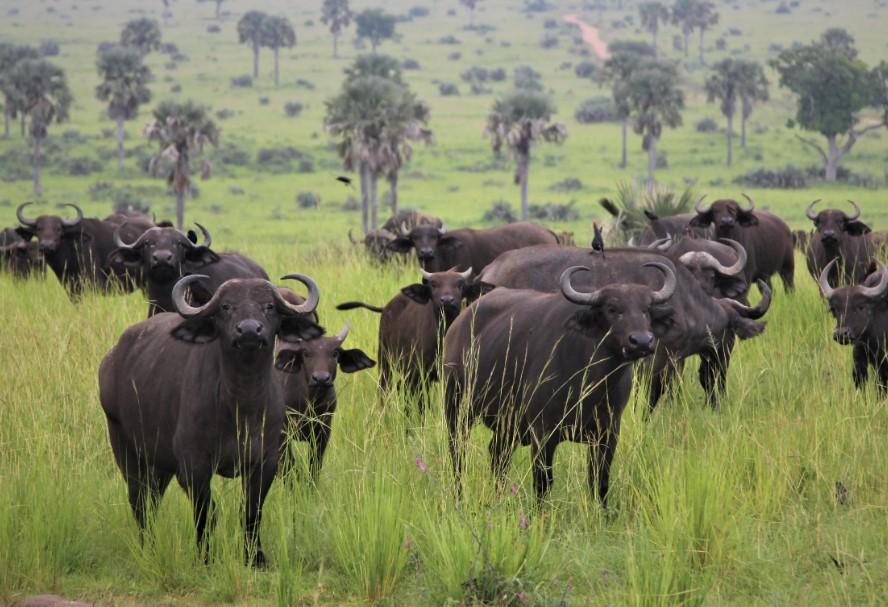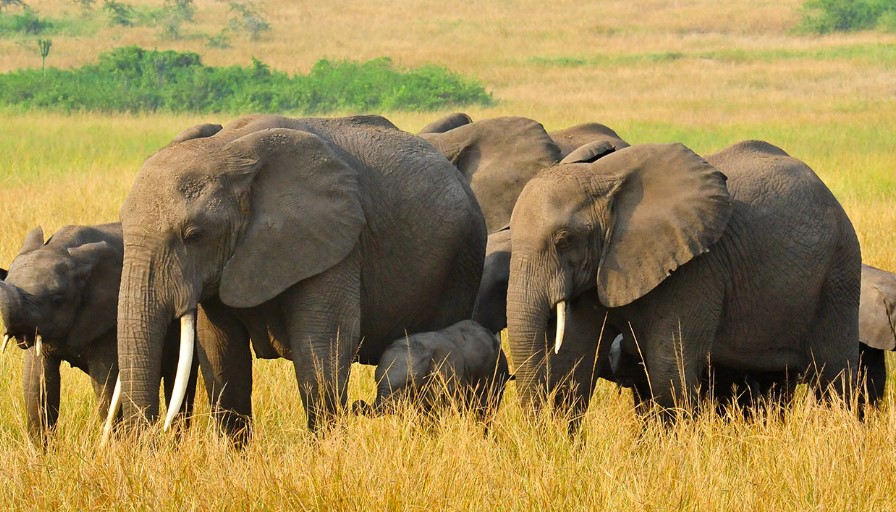The Majestic Big Five of Queen Elizabeth National Park: A Wildlife Wonderland – Queen Elizabeth National Park, located in southwestern Uganda, is a biodiverse haven and a wildlife enthusiast’s dream come true. Spanning over 1,978 square kilometers, this magnificent park is a living testament to the conservation efforts in East Africa.
Among its remarkable wildlife, the Big Five takes center stage, showcasing some of the most iconic and awe-inspiring creatures on the planet. This article delves into the captivating world of the Big Five animals in Queen Elizabeth National Park, highlighting their significance, behavior, and the conservation challenges they face.
The Mighty African Elephant
As the largest land mammals on Earth, African elephants (Loxodonta africana) hold an exalted place in Queen Elizabeth National Park’s ecosystem. These gentle giants roam the savannah in small herds, exhibiting complex social structures led by a matriarch.
Their incredible size, characterized by their massive tusks and long trunks, makes them an awe-inspiring sight for visitors. Queen Elizabeth National Park is home to both savannah and forest elephants, with the latter being a rare and elusive sight.
Despite their seemingly indestructible nature, African elephants face severe threats from poaching, habitat loss, and human-wildlife conflicts. Conservation initiatives within the park aim to safeguard their future, offering hope for the survival of these magnificent creatures.
The Formidable African Buffalo
Known for their robust physiques and iconic horns, the African buffalo (Syncerus caffer) is another crucial member of the Big Five in Queen Elizabeth National Park. These gregarious creatures often form massive herds, sometimes consisting of hundreds of individuals. Their presence significantly impacts the park’s ecosystem, as they play a vital role in shaping vegetation patterns through grazing and trampling.
Although African buffalos appear docile in their herds, they can be unpredictable and aggressive when threatened. Poaching and disease outbreaks pose significant threats to their populations, emphasizing the importance of conservation efforts to maintain a healthy balance between these magnificent creatures and the environment they inhabit.
The Regal African Lion
The African lion (Panthera leo) reigns as the king of the savannah in Queen Elizabeth National Park. The iconic “king of beasts” captivates visitors with its majestic presence, golden mane, and powerful roars that resonate through the grasslands. Lions are highly social animals, forming prides with intricate hierarchies, led by a dominant male.
However, the African lion faces numerous challenges in the modern world. Habitat loss, human-wildlife conflicts, and trophy hunting continue to threaten their populations across Africa. Conservation efforts in Queen Elizabeth National Park aim to protect these magnificent creatures and ensure they continue to roam the savannah as an emblem of wild Africa.
The Graceful African Leopard
The African leopard (Panthera pardus) is an elusive and enigmatic member of the Big Five in Queen Elizabeth National Park. Renowned for their striking coat pattern and stealthy hunting prowess, leopards thrive in diverse habitats, including woodlands, savannahs, and forests. Unlike lions, leopards are solitary creatures, preferring a more discreet and solitary lifestyle.
Despite their adaptability, leopards face challenges in maintaining their populations. Habitat fragmentation, poaching for their striking coats, and conflicts with humans are some of the threats they encounter. Efforts to conserve these elusive felines are crucial to preserve the park’s ecological balance and maintain the charm of encountering them in their natural environment.
The Majestic African Elephant
Rounding out the Big Five is the African rhinoceros, both the black rhino (Diceros bicornis) and the white rhino (Ceratotherium simum). The black rhino is a solitary and sometimes aggressive species, while the white rhino is more social and grazes in groups.
Unfortunately, both species face severe threats from poaching for their horns, which are highly sought after in illegal wildlife trade. Conservation efforts within Queen Elizabeth National Park and other protected areas strive to protect these magnificent creatures, ensuring their survival for future generations to admire and cherish.
In Conclusion Queen Elizabeth National Park is a treasure trove of biodiversity, and its Big Five animals hold a special place in the hearts of nature enthusiasts and conservationists alike. From the mighty African elephant to the elusive leopard, these remarkable creatures contribute to the park’s ecological balance and its status as a premier wildlife destination.
However, they also face numerous challenges, and efforts to protect them and their habitats remain paramount.
By supporting conservation initiatives and promoting responsible tourism, we can ensure that the Big Five of Queen Elizabeth National Park continue to inspire awe and wonder for generations to come. Together, we can safeguard the future of these magnificent creatures and preserve the natural heritage they embody.



Comment (0)